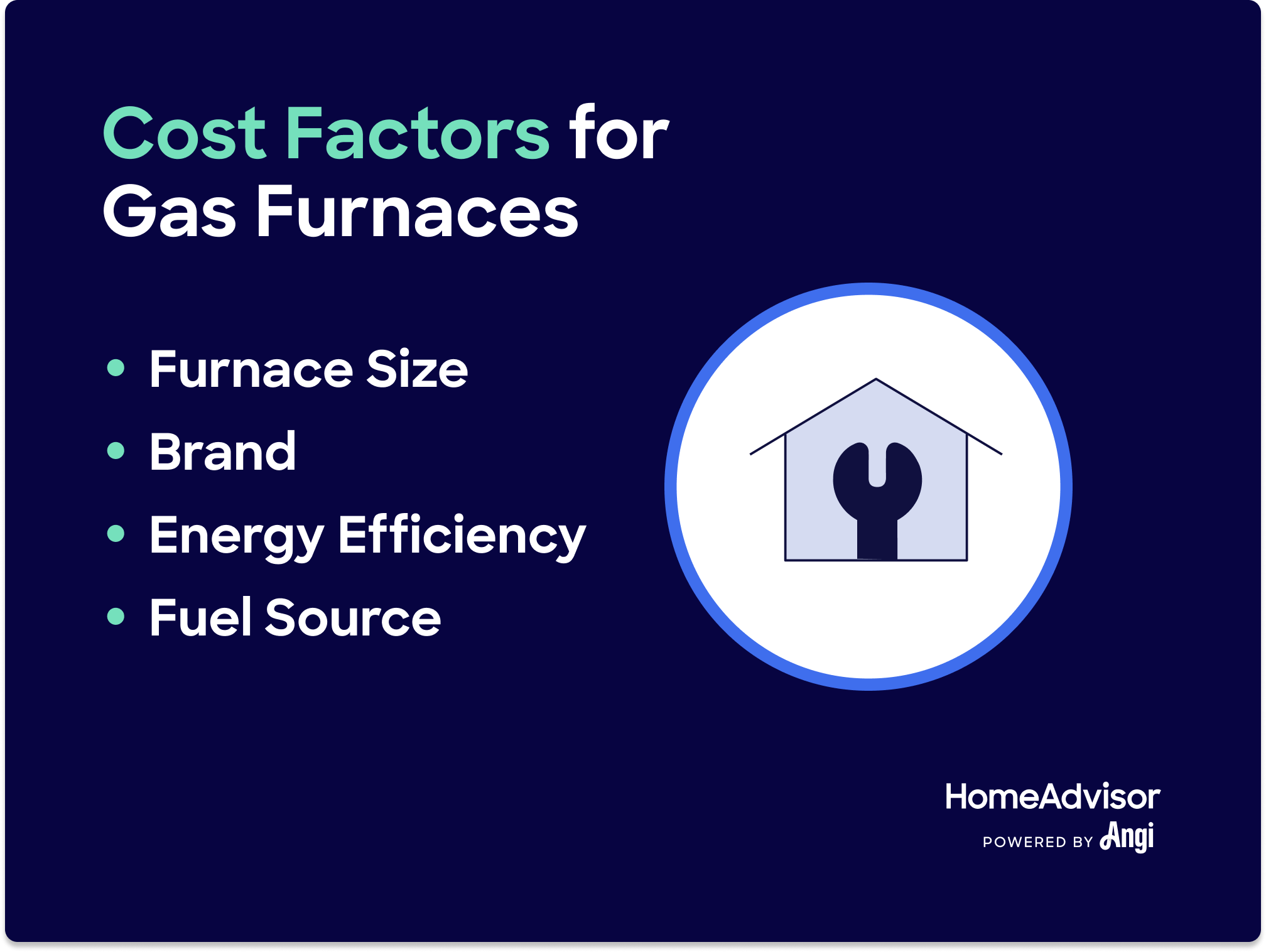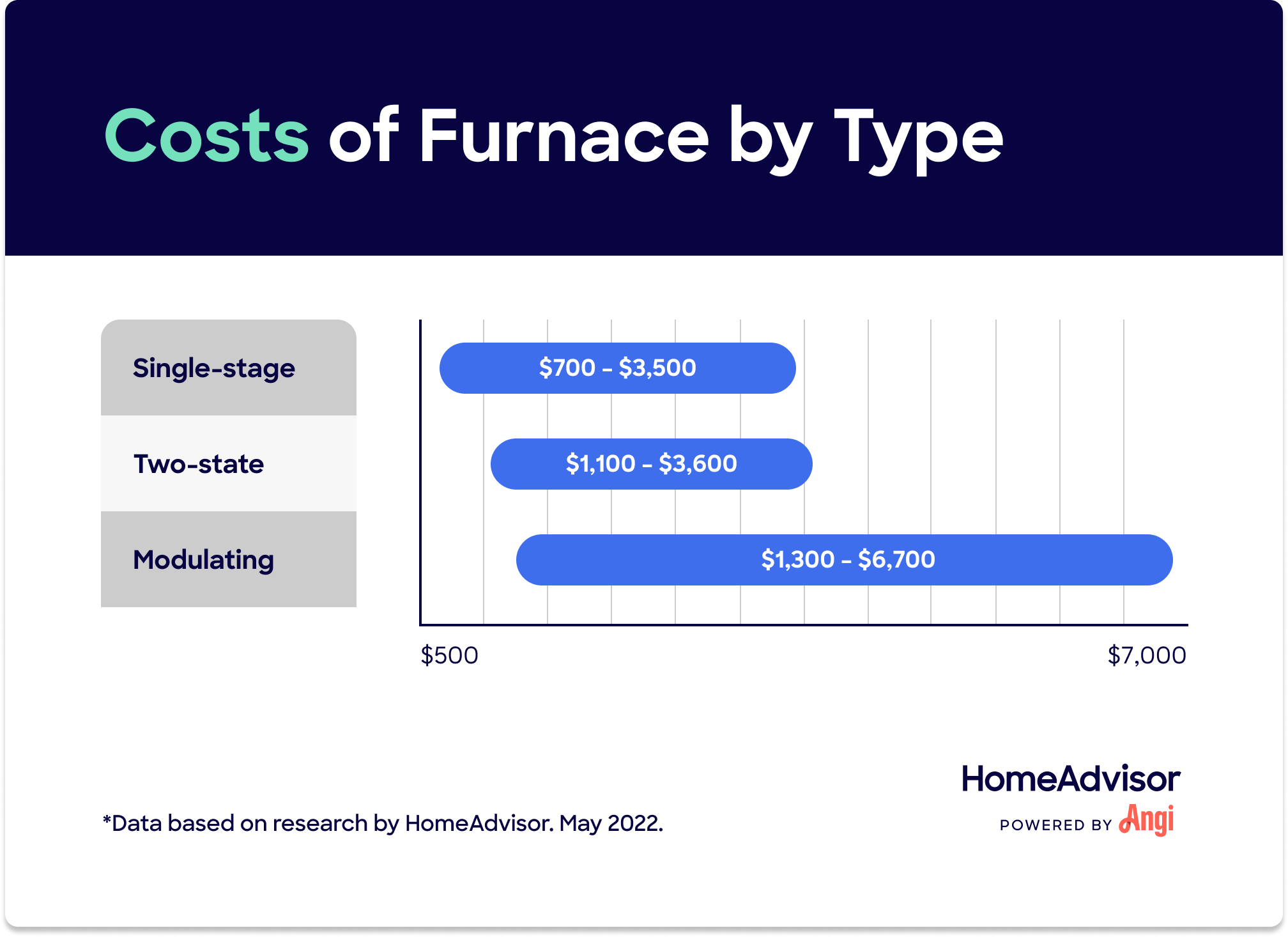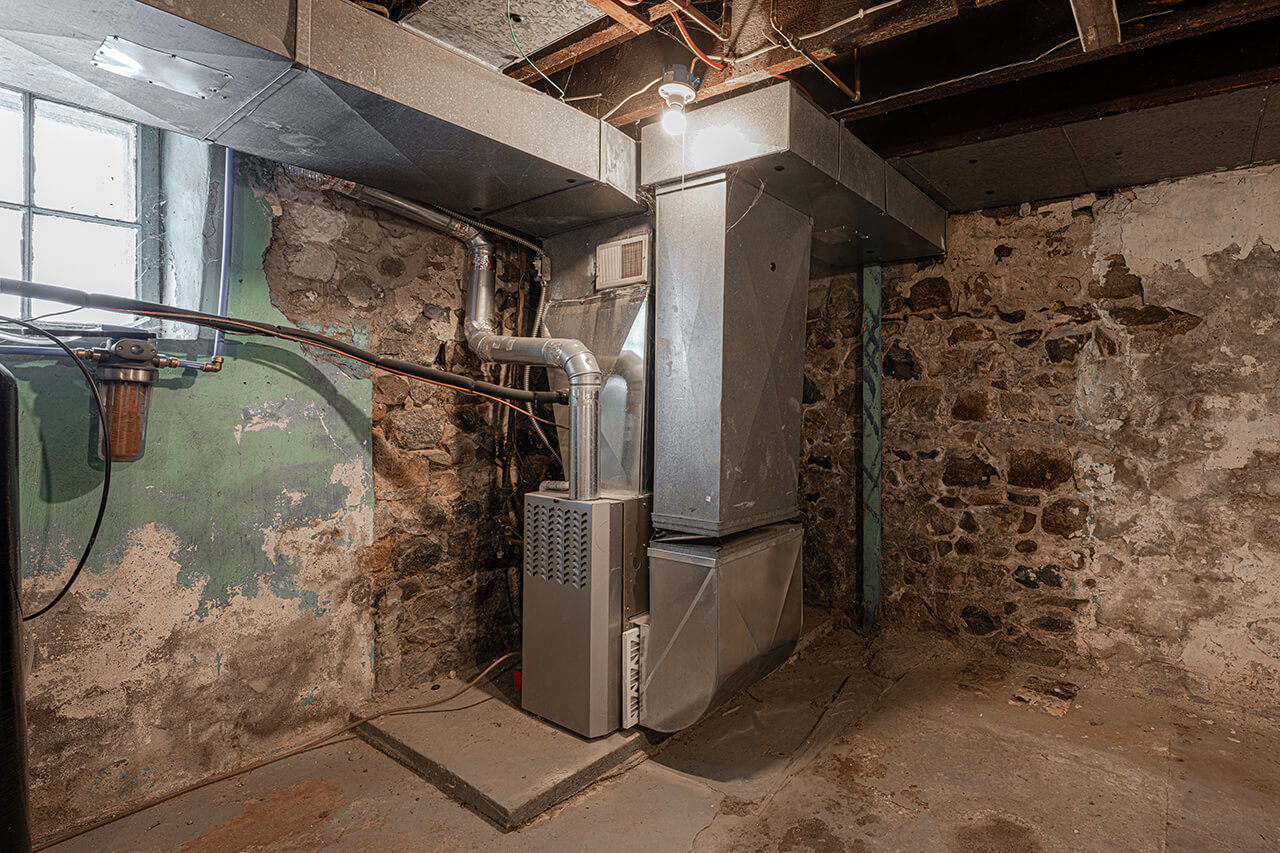How Much Does a New Gas Furnace Cost?
Typical Range:
$700 - $3,500
Typical Range:
$700 - $3,500
Cost data is based on research by HomeAdvisor.
Updated May 26, 2022
Written by HomeAdvisor.A new gas furnace will cost $700 to $3,500 for the unit alone, but the average gas furnace cost comes in around $2,100. High-efficiency gas furnace prices can reach as high as $6,000 for the unit alone. Gas furnace installation costs are much higher, up to $10,000, when you factor in the cost of the unit plus ducts, labor, and materials.
Natural gas furnaces are the most popular way to heat homes—for good reason. They’re fairly cheap to install and easy on the monthly budget. Our new gas furnace cost guide will examine average natural gas furnace prices and break down the cost by various factors, including furnace size, energy efficiency, and brand.
| Average Cost | $2,100 |
| High Cost | $3,500 |
| Low Cost | $700 |
A new gas furnace cost can vary depending on the furnace size, the size of the home you’re heating, its energy efficiency, the fuel source (true natural gas vs. propane), and whether it’s a downflow or upflow unit.
Shopping for the cheapest furnace you can find may not save you the most in the long term. Consider the efficiency of the furnace and its durability when making your decision.
| Furnace Size (BTU) | Typical Furnace Cost with Installation* |
|---|---|
| 40,000 | $2,000 – $3,500 |
| 50,000 | $2,300 – $3,800 |
| 60,000 | $2,500 – $4,200 |
| 75,000 | $2,700 – $4,600 |
| 80,000 | $3,000 – $4,900 |
| 100,000 | $3,400 – $5,400 |
| 120,000 | $4,000 - $6,000 |
*Prices reflect a standard 80%-85% AFUE rating. High-efficiency furnaces add 50% to 100% more cost. The table above shows the full furnace installation cost, including labor and materials, by size. In fact, the primary factor for a new gas furnace cost is the size.
We measure furnace size in BTUs, or British thermal units. BTUs reflect the amount of heat required to raise the temperature of 1 pound of water by 1 degree Fahrenheit.
How does that translate to furnace size? Gas furnaces range from 40,000 BTUs for a small space in a moderate climate to 125,000 BTUs for a large space in a colder climate, but you can find furnaces offering as low as 25,000 BTUs and more than 150,000 BTUs.
Because older homes aren’t insulated as well as newer homes, they often require higher BTU models. However, the two biggest factors in determining BTUs are the size of your home and your climate zone.
The size of your home has a huge impact on the BTUs the furnace needs and thus overall gas furnace prices. A 1,000-square-foot home might need 45,000to 50,000 BTUs (with a furnace cost of $600 to $1,900) while a 2,000-square-foot home could need 90,000 to 100,000 BTUs (at a new gas furnace cost of $900 to $2,600).
| Square Footage of House | Average BTUs Needed | Average Cost of Gas Furnace Unit |
|---|---|---|
| 1,000 square feet | 45,000 – 50,000 BTUs | $600 – $,1900 |
| 2,000 square feet | 90,000 – 100,000 BTUs | $700 – $2,200 |
| 3,000 square feet | 135,000 – 150,000 BTUs | $1,200 – $5,600 |
Climate zone can have a major impact on the size of the furnace your home requires. Homes in the hottest parts of the country may only need 30 to 35 BTUs per square foot, while homes in the coldest parts of the country need 50 to 60 BTUs per square foot. Your needs can nearly double the gas furnace cost for houses in colder climates.
Consult the U.S. Department of Energy’s climate zone map to determine your climate zone. What the Department of Energy designates as the Hot-Humid, Hot-Dry, and Mix-Dry areas will, in general, need fewer BTUs per square foot than areas in the Cold and Very Cold areas.
A local furnace installation contractor will be familiar with the typical heating requirements for homes in your climate zone.
High-efficiency furnaces can cost $2,000 to $6,000, about twice the cost of a standard efficiency unit. Including installation, high-efficiency furnace costs can reach $13,000.
| Type | AFUE | Approximate Unit Cost |
|---|---|---|
| Standard Efficiency | 80% – 89% | $500 – $1,500 |
| Moderate Efficiency | 90% – 95% | $1,000 – $3,000 |
| High Efficiency | 96%+ | $2,000 – $6,000 |
The Annual Fuel Efficiency (AFUE) rating evaluates the efficiency of a furnace. Furnaces rated 90% or more are widely considered high efficiency, but there is a price difference between 90% and 95% (moderate efficiency) and 96% and above (true high efficiency). A furnace with an AFUE rating of 80 is 80% efficient; one with a rating of 90 is 90% efficient.
High-efficiency models increase comfort (less temperature fluctuation in your home), run more quietly, and can save you money in the long run via lower monthly utility bills and potential tax and rebate incentives.
In general, there are three types of furnaces to consider:
Single-stage furnaces: $700–$3,500. These are the most common furnaces and have a very basic on-off mechanism. That means there is a single heat setting. These tend to be the most affordable but the least efficient and least comfortable.
Two-stage furnaces: $1,100–$3,600. A two-stage furnace offers more comfort and better efficiency because it includes both high and low settings.
Modulating furnaces: $1,300–$6,700. The newest type of furnace is a variable-capacity system with a variable-speed blower. These use computer-controlled thermostats, allowing you to be more specific about temperature. This can be much more efficient but can cost a lot more to purchase and install.
A natural gas furnace cost can range from $700 to $3,500 for a standard efficiency model, but you can also consider an alternative fuel source, propane, for roughly the same price: $700 to $3,600.
The cost to install a propane furnace can be $1,000 to $2,000 cheaper than a natural gas furnace, but heating your home with propane can cost from $1,000 to $2,500 per year; that’s potentially double or triple the cost of heating with natural gas.
Propane, however, works for off-grid and rural homes.
Downflow and upflow furnaces cost anywhere from $700 to $3,500 for standard efficiency models. The cost to install each type might vary depending on the ease of access and the level of ductwork installation required by the furnace contractor you hire.
Downflow furnaces bring cool air from the top and blow out heated air from the bottom. This makes them ideal for attic spaces, mobile homes, and houses without basements.
Upflow furnaces do just the opposite: taking cool air in from the bottom of the air handler and pushing out heated air at the top. You can heat a home with a basement more efficiently with an upflow furnace.
Comparisons for gas furnaces show a fluctuation of $1,000 to $2,000 between brands. Below are some of the top brands and their approximate costs, including installation.
| Brands | Standard | High Efficiency |
|---|---|---|
| Amana/Daikin/Goodman | $2,500 - $5,500 | $5,000 - $8,000 |
| American Standard/Trane | $2,000 - $8,000 | $3,000 - $13,000 |
| Carrier/Bryant/Day and Night | $2,000 - $9,000 | $4,500 - $13,000 |
| Lennox | $3,000 - $10,000 | $5,000 - $15,000 |
| Maytag/Frigidaire | $2,000 - $7,000 | $4,500 - $11,000 |
| Payne | $1,750 - $5,000 | $5,000 - $10,000 |
| Rheem/Ruud | $2,500 - $7,000 | $4,500 - $10,000 |
| York/Coleman | $2,000 - $6,000 | $4,000 - $10,000 |
Contractors buy wholesale then markup the price 30% to 50%. Wholesale prices generally aren’t available to the public.
| Installation Cost Factors | Cost |
|---|---|
| Duct Installation | $450 – $2,050 |
| Labor | $50 – $150 per hour |
| Fees and Permits | $250 – $400 |
| Furnace Conversion | $150 – $6,500 |
Installing new ductwork costs$450 to $2,050 with a general cost of $10 to $20 per linear foot. Even if you have existing ductwork, you might need to replace it if your contractor detects leaks. Leaks can lead to a loss of 10% to 30% of the heat from your furnace. Properly sealed ductwork reduces this loss to less than 5% on average.
Down the line, expect regular ductwork maintenance costs:
Cleaning ducts costs$275 to $500.Get an inspection and cleaning at least once a year.
A home energy audit costs$200 to $700 and helps discover leaks.
Asbestos remediation costs$1,150 to $3,050. Older homes might have ducts lined or covered in asbestos. These present a serious health hazard and should never be touched by homeowners. If you suspect this type of lining, contact an asbestos inspector near you. But don’t be alarmed. Most professionals agree that asbestos isn’t harmful until it’s disturbed.
Labor runs $50 to $150 per hour with each worker clocking an additional $50 per hour. Installation runs about 4 hours for a simple replacement and 10 to 15 hours for a straightforward new install.
Building permits cost from $450 to $2,300 in general, but for an HVAC job like a new furnace installation, expect to spend between $250 and $400.
Most permits require inspection at various stages of the process. However, it’s not a bad idea to get an independent inspection from an outside source after the install.
Furnace conversion costs can range from as little as $150 for a natural gas to propane conversion or $500 to$6,500 for the removal of an oil heater and installation of a new gas furnace.
Going from natural gas to propane is easy. You just need to purchase a conversion kit for roughly $50 to $150, then hire a contractor to install it. Labor costs should fall between $100 to $150 for the conversion.
However, removing an old oil fuel tank can cost between $500 and $6,500. It ranges so widely because of local regulations and how complex your project might be.
The cheapest furnace might cost as little as $700. If you can find it, wholesale or used gas furnaces can save you as much as half the price of a new one. However, most pros don’t guarantee work or parts on used units.
Replacing a gas furnace with one of similar size costs between $2,000 and $6,800 for standard types.
Depending on the brand and quality, you’ll get 15 to 30 years out of a gas furnace.
Natural gas is cheaper than both propane and electric. Propane is sometimes cheaper than electric to heat your home, but that’s not always the case. Because of seasonal and regional fluctuations in propane and electricity prices, check with a local HVAC professional.
Propane furnaces use half the fuel of natural gas, but propane prices are much higher. They’re more environmentally responsible but cost more to run.
High-efficiency furnaces are worth the investment if you’re looking for:
Lower monthly utility bills.
Less greenhouse gas emissions.
More even temperatures throughout your home.
Quieter heating.
If the timing works out, it can be a good idea to replace your furnace and air conditioning system at the same time. Newer systems are more efficient than what you likely have installed currently, and matched HVAC systems (furnace and AC sharing the same air handler) can make each other function more efficiently.
The main difference between a furnace and a boiler is how they heat your home. In the simplest terms, a furnace uses warm air while a boiler uses hot water or steam. A new boiler installation costs from $3,700 to $8,300.


